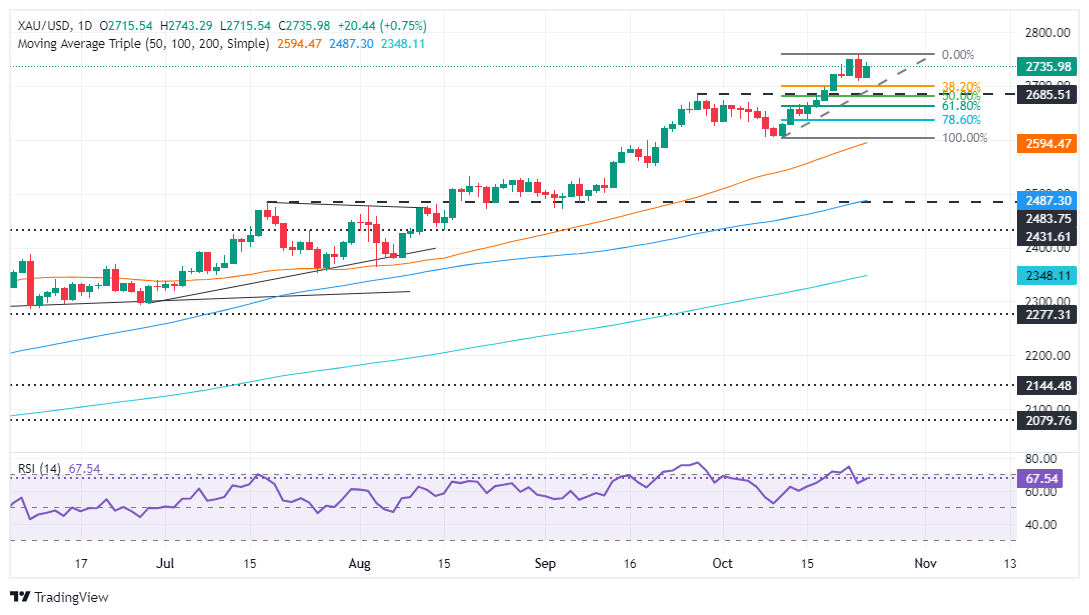Gold prices soared due to geopolitical tensions, declining US yields
- Gold advances as US Treasury yields fall alongside the US Dollar.
- Tensions due to the Middle East and US election boost Bullion’s demand.
- Strong US labor market data and better-than-expected PMI results underscore economic resilience despite mixed housing data.
- Analysts highlight rising US fiscal debt concerns as key factors supporting Gold's rally.
Gold prices climbed late on Thursday as US Treasury yields dropped on demand for safe-haven assets. Heightened tensions in the Middle East and US election woes underpin the golden metal. At the time of writing, the XAU/USD trades at $2,734, up 0.72%.
Risk appetite has improved, as portrayed by Wall Street trading in the green. US data reveals that the labor market remains solid and not as weak as projected by the Federal Reserve (Fed), which cut rates by 50 basis points (bps) in its last meeting due to fears of over-tightening monetary policy.
The US economy continued to strengthen as S&P Global Flash PMIs fared better than expected. Despite this, US housing data was mixed with Building Permits tumbling, while New Home Sales rose.
ANZ analysts commented, "Concerns around the rising US fiscal debt outlook is strengthening the investment case for Gold.”
Sources cited by Reuters stated, “Uncertainty leading into the US election is one additional pillar of support for the Gold market, given the unease that the market may be feeling going into the election.”
Gold’s advance reflects traders' uncertainty about the outcome of the US election, as markets expect a narrowly contested race. Former President and Republican nominee Donald Trump was seen gaining an edge over Vice President Kamala Harris in the upcoming election, which is less than two weeks away.
In the geopolitics space, Israeli officials delivered strong rhetoric against Iran. An Israeli strike on Tehran might lead to a further escalation of hostilities.
Daily digest market movers: Gold price counter-attacks as US yields tumble
- The US 10-year Treasury note yield fell five basis points to 4.20%.
- The DXY, which measures the performance of the US currency against another six, edges down 0.37% at 104.00.
- Initial Jobless Claims for the week ending October 19 rose to 227K, below estimates of 242K and the previous reading of 241K.
- October S&P Global Manufacturing PMI came in at 47.8, up from 47.3 in September and exceeding the forecast of 47.5. The Services PMI also improved, rising from 55.2 to 55.3, above analysts' projection of 55.0.
- New Home Sales in September grew 4.1% from 0.709 million to 0.738 million.
- Data from the Chicago Board of Trade, based on the December fed funds rate futures contract, indicates that investors estimate 47 basis points (bps) of Fed easing by the end of the year.
XAU/USD technical outlook: Gold price rises above $2,730
Gold price advanced continued despite the formation of a Bullish Engulfing candle pattern on the daily chart, which was invalidated as of writing as XAU/USD edges higher.
Momentum suggests that buyers are moving in. The Relative Strength Index (RSI) halted its downfall and resumed upwards in bullish territory.
If XAU/USD clears $2,750, the next resistance would be the year-to-date (YTD) high at $2,758. Once surpassed, the next stop would be $2,800.
On the flip side, if Bullion prices edge below the October 23 low of $2,708, the next support would be the 38% Fibonacci Retracement at $2,699, followed by the 50% and 61.8% Fib Retracements at $2,681 and $2,662, respectively.

Gold FAQs
Gold has played a key role in human’s history as it has been widely used as a store of value and medium of exchange. Currently, apart from its shine and usage for jewelry, the precious metal is widely seen as a safe-haven asset, meaning that it is considered a good investment during turbulent times. Gold is also widely seen as a hedge against inflation and against depreciating currencies as it doesn’t rely on any specific issuer or government.
Central banks are the biggest Gold holders. In their aim to support their currencies in turbulent times, central banks tend to diversify their reserves and buy Gold to improve the perceived strength of the economy and the currency. High Gold reserves can be a source of trust for a country’s solvency. Central banks added 1,136 tonnes of Gold worth around $70 billion to their reserves in 2022, according to data from the World Gold Council. This is the highest yearly purchase since records began. Central banks from emerging economies such as China, India and Turkey are quickly increasing their Gold reserves.
Gold has an inverse correlation with the US Dollar and US Treasuries, which are both major reserve and safe-haven assets. When the Dollar depreciates, Gold tends to rise, enabling investors and central banks to diversify their assets in turbulent times. Gold is also inversely correlated with risk assets. A rally in the stock market tends to weaken Gold price, while sell-offs in riskier markets tend to favor the precious metal.
The price can move due to a wide range of factors. Geopolitical instability or fears of a deep recession can quickly make Gold price escalate due to its safe-haven status. As a yield-less asset, Gold tends to rise with lower interest rates, while higher cost of money usually weighs down on the yellow metal. Still, most moves depend on how the US Dollar (USD) behaves as the asset is priced in dollars (XAU/USD). A strong Dollar tends to keep the price of Gold controlled, whereas a weaker Dollar is likely to push Gold prices up.